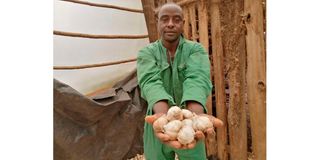Boom for farmer who spiced up his earnings by growing garlic

Timothy Mburu at his garlic farm in Gitinga village, Kieni, Nyeri County.
What you need to know:
- Timothy Mburu's first harvest was 800 kilos from a quarter-acre on which he had farmed on experimental basis.
- This motivated him to grow the crop and learn more on increasing productivity.
Gitinga village is located on the foot of Mt Kenya in Kieni, Nyeri County. It is here that Timothy Mburu owns three acres where he farms garlic and other crops.
“I have been farming since 2012, growing mainly potatoes and cabbages, but I diversified to garlic in 2018,” says Mburu, who holds a Diploma in Agribusiness and Crop Management from Jomo Kenyatta University of Science and Technology.
He diversified to the onions after establishing that there was a shortage in the market.
“Garlic is a high value crop with great demand. Most people go for it because of its medicinal value.”
His first harvest was 800 kilos from a quarter-acre on which he had farmed on experimental basis. This motivated him to grow the crop and learn more on increasing productivity.
“On the other hand, I sold the produce at Sh180 a kilo, through a broker, which was good money but I did not know that I could actually establish my own direct link to the market,” he says.
From the recent crop that he planted in May, he harvested after four months 1.5 tonnes from the quarter acre. The secret to high yields, according to him, is good agriculture practices that involve thorough land preparation, proper fertiliser application, prevention of pests and diseases and proper weeding.
Maturity of garlic
For garlic, one plants cloves. The seeds are taken through a process known as natural seasoning.
“This a process that starts from garlic maturity, post-harvesting, drying, splitting, sorting and lastly storage. It takes not less three months and the main focus is to reduce the maturity period to three months. One focuses on shoot development and moisture reduction,” he notes.
He sells the seeds to farmers, says Mburu, who grows the Moyale variety that produces big cloves and has a stronger smell, therefore, most restaurant operators prefer it. Another advantage of the variety is that it is easier to peel.
According to Mburu, maturity of garlic depends on seed development.
"It can take between four and 15 months. Usually, if the shoot inside the clove was developed to 80 per cent before planting, it takes less duration to grow."
When he started farming with 200 kilos of garlic seeds, his cost of production per kilo was Sh70. It now stands at Sh10 per kilo.
“I achieved this by developing my own seeds. And since they mature faster, weeding times have reduced cutting down on costs. Garlic is weeded once a month.”
After harvesting, one must do grading since the cost is determined by the quality and size of the garlic.

Timothy Mburu at his garlic farm in Gitinga village, Kieni, Nyeri County.
Usually, for grades one and two, which are bigger, a kilo sells for between Sh250 and Sh300.
“I use the medium and small bulbs for seed development, which I sell at Sh400 a kilo. Seeds costs more because they must be dried thoroughly."
Agronomist John Wambugu, who is based in Nyeri, notes that diseases that affect garlic include purple blotch, which affects the leaves, downey mildew, rust and bulb rot.
The most common pests include onion thrips and nematodes.
“For the seeds, we rely on vegetative propagation and planting is spaced at 30cm between rows and 15 to 20cm between plants.”
The crop needs an altitude of between 500 to 2,000 meters above sea level, which is mainly areas with high temperatures of up to 300C.
“During the initial stages, they require lower temperatures but later, during development, they need higher temperatures which help the crop to develop stronger scents and have better oils levels.” He notes that garlic requires seasons with long days with up to 12 hours of sunlight in order to record better yields.





